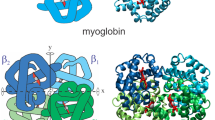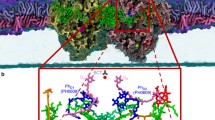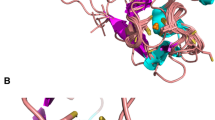Abstract
The molecular basis of Rubisco's specificity is investigated in terms of the structure and kinetics of the enzyme. We propose that the rates of the conformational changes (closing/opening) of the binding niche exert a crucial influence on apparent binding rates and the enzyme's specificity. An extended reaction scheme for binding and conformational kinetics is presented and expressed in a mathematical model. The closed conformation, known from X-ray structures, is assumed to be necessary for binding of the gaseous substrates (carbon dioxide and oxygen) and for catalysis. Opening the niche interrupts catalysis and enables a fast exchange of those molecules between the internal cavity and the surrounding solvent. Our model predicts that specificity of Rubisco for CO2 increases with the rate by which the niche opens. This is due to the fact that binding of the carbon dioxide is faster than oxygen binding, which is hampered by spin inversion. The apparent rate of carbon dioxide binding correlates with the repetition rate of the conformational change, and the rate of oxygen binding with the probability of the closed state.
Similar content being viewed by others
References
Andersson I (1996) Large structures at high resolution: The 1.6 A crystal structure of spinach ribulose-1,5-bisphosphate carboxylase/oxygenase complexed with 2-carboxyarabinitol bisphosphate. J Mol Biol 259: 160–174
Andrews TJ and Lorimer GH (1987) Rubisco: Structure, mechanisms and perspectives for improvement. In: Hatch MD and Boardman NK (eds) The Biochemistry of Plants: A Comprehensive Treatise, Vol. 10, pp 131–218. Academic Press, New York
Bainbridge G, Anralojc PJ, Madgwick PJ, Pitts JE and Parry MAJ (1998) Effect of mutation of lysine-128 of the large subunit of ribulose bisphosphate carboxylase/oxygenase from Anacystis nidulans. Biochem J 336: 387–393
Bainbridge G, Madgwick P, Parmar S, Mitchell R, Paul M, Pitts J, Keys Alfred J and Parry MAJ (1995) Engineering Rubisco to change its catalytic properties. J Exp Bot 46: 1269–1276
Farquhar GD (1979) Models describibg the kinetics of ribulose bisphosphate carboxylase-oxygenase. Arch Biochem Biophys 193: 456–468
Gutteridge S, Millar B and Parry MA (1986) Inactivation of ribulose bisphosphate carboxylase by limited proteolysis. FEBS Lett 196: 263–268
Gutteridge S, Parry MA, Godfrey CN, and Feeny, J (1984) An investigation of ribulosebisphosphate carboxylase activity by high resolution 1H NMR. FEBS Lett 170: 355–359
Gutteridge S, Rhoades DF and Herrmann C (1993) Site-specific mutations in a loop region of the C-terminal domain of the large subunit of ribulose bisphosphate carboxylase/oxygenase that influence substrate partitioning. J Biol Chem 268: 7818–7824
Jordan DB and Ogren WL (1981) Species variation in the specificity of ribulosebisphosphate carboxylase-oxygenase. Nature 291: 513–515
King WA, Gready JE and Andrews TJ (1998) Quantum chemical analysis of the enolization of ribulose bisphosphate: The first hurdle in the fixation of CO2 by Rubisco. Biochemistry 37: 15414–15422
Knight S, Andersson I and Bränden C-I (1990) Crystallographic analysis of ribulose 1,5-bisphosphate carboxylase from spinach at 2.4 Å resolution. J Mol Biol 215: 113–160
Kostov RV, Small CL and McFadden BA (1997) Mutations in a sequence near the N-terminus of the small subunit alter the CO2/O2 specificity factor for ribulose bisphosphate carboxylase/oxygenase. Photosynth Res 54: 127–134
Laidler KJ (1965) Chemical Kinetics. McGraw-Hill, New York
Larson EM, Larimer FW and Hartman FC (1995) Mechanistic insights provided by the deletion of a flexible loop at the active site of ribulose-1,5-bisphosphate carboxylase/oxygenase. Biochemistry 34: 4531–4537
Laskowski RA (1995) A program for visualizing molecular surfaces, cavities and intermolecular interactions. J Mol Graph 13: 323–330
Madgwick PJ, Parmar S and Parry MAJ (1998) Effect of mutations of residue 340 in the large subunit polypeptide of Rubisco from Anacystis nidulans. Eur J Biochem 253: 476–479
Moliner V, Andres J, Oliva M, Safont S and Tapia O (1999) Transition state structure invariance to the model system size and calculation levels: A QM/MM study of the carboxylation step catalyzed by rubisco. Theor Chem Acc 101: 228–223
Mulligan RM, Loutz RL and Tolbert NE (1988) Reaction-intermediate analogue binding by ribulose bisphosphate carboxylase/oxygenase causes specific changes in proteclytic sensitivity: The amino-terminal residue of the large subunit is acetylated proline. Proceedings of the National Academy of Sciences, NY 85: 1513–1517
Newman J and Gutteridge S (1993) The X-ray structure of Synechococcus ribulose-bisphosphate carboxylase/oxygenase activated complex at 2.2-A resolution. J Biol Chem 34: 25876–25886
O'Leary MH (1992) Catalytic strategies in enzymic carboxylation and decarboxylation. In: Sigman DS (ed) The Enzymes, Vol XX, pp 235–268, Academic Press, San Diego
Pierce J, Lorimer GH and Reddy GS (1986) Kinetic mechanism of ribulosebisphosphate carboxylase: Evidence for ordered, sequential reaction. Biochemistry 25: 1636–1644
Portis AR Jr. (1990) Partial reduction in ribulose-1 5-bisphosphate carboxylase-oxygenase activity by carboxypeptidase a. Arch Biochem Biophys 283: 397–400
Ranty B, Lundqvist T, Schneider M, Madden R, Howard R and Lorimer G (1990) Truncation of ribulose-1,5-bisphosphate carboxylase-oxygenase from R. rubrum affects the holoenzyme assembly and activity. EMBO J 9: 1365–1374
Roy H and Andrews TJ (1999) Rubisco: Assembly and mechanism. In: Leegood RC, Sharkey TD and Von Caemmerer S (eds) Photosynthesis: Physiology and Metabolism. Kluwer Academic Publishers, Dordrecht, The Netherlands
Sugawara H, Yamamoto H, Shibata N, Inoue T, Okada S, Miyake C and Kai Y (1999) Crystal structure of carboxylase reaction-oriented ribulose 1,5-bisphosphate carboxylase/oxygenase from a thermophilic red alga, Galdieria partita. J Biol Chem 274: 15655–15661
Taylor TC and Andersson I (1997) The structure of the complex between rubisco and its natural substrate ribulose 1,5-bisphosphate. J Mol Biol 265: 432–444
Uemura K, Suzuki Y, Shiknai T, Wadano A, Jensen RG, Chmura W and Yokota A (1996) A rapid and sensitive method for determination of relative specificity of chloroplast Rubisco from various species by anion-exchange chromatography. Plant Cell Physiol 37: 325–331
Wildner GF, Schlitter J and Stuetzel T (1999) Phylogenetic analysis of the C-terminal sequence of rbel. Plant Biol 1: 656–664
Wildner GF, Schlitter J and Mueller M (1996) Rubisco, an old challenge with new perspectives. Z Naturforsch 51C: 263–276
Zhu G, Jensen RG, Bohnert H-J, Wildner GF and Schlitter J (1998) Dependence of catalysis and CO2/O2 specificity of Rubisco on the carboxy-terminus of the large subunit at different temperatures. Photosynth Res 57: 71–79
Author information
Authors and Affiliations
Corresponding author
Rights and permissions
About this article
Cite this article
Schlitter, J., Wildner, G.F. The kinetics of conformation change as determinant of Rubisco's specificity. Photosynthesis Research 65, 7–13 (2000). https://doi.org/10.1023/A:1006425607995
Issue Date:
DOI: https://doi.org/10.1023/A:1006425607995




